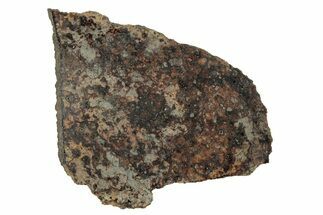.92" Gold Basin Chondrite Meteorite (7.1 g) - Arizona
This is a .92" wide (7.1 gram) fragment of the chondrite meteorite known as Gold Basin. Its surface is quite weathered and coated in patina, but it still contains traces of fusion crust.
About The Gold Basin Meteorite
The meteorite known as Gold Basin is an L4 chondrite found in Mojave County, Arizona in 1995. Jim Kriegh, a local hobby prospector and professor at the University of Arizona, stumbled upon the meteorite among arroyos while detecting for gold. Since its finding, well over 100 kilograms of material have been recovered, and its strewn field is considered one of the oldest and most thoroughly mapped on Earth.
Gold Basin has been found by gold prospectors before, but its stones were usually dismissed as hot rocks before Kriegh's discovery. Though a low-iron variety of chondrite, it still has enough nickel-iron to set off metal detectors. It likely fell sometime during the Wisconsin Glaciation, about 15,000 years ago.
When sliced, this meteorite shows a multitude of gray to black silicate clasts with grains of detectable nickel-iron.
The meteorite known as Gold Basin is an L4 chondrite found in Mojave County, Arizona in 1995. Jim Kriegh, a local hobby prospector and professor at the University of Arizona, stumbled upon the meteorite among arroyos while detecting for gold. Since its finding, well over 100 kilograms of material have been recovered, and its strewn field is considered one of the oldest and most thoroughly mapped on Earth.
Gold Basin has been found by gold prospectors before, but its stones were usually dismissed as hot rocks before Kriegh's discovery. Though a low-iron variety of chondrite, it still has enough nickel-iron to set off metal detectors. It likely fell sometime during the Wisconsin Glaciation, about 15,000 years ago.
When sliced, this meteorite shows a multitude of gray to black silicate clasts with grains of detectable nickel-iron.
What is an L4 Chondrite?
An L4 chondrite is a type of ordinary chondritic meteorite, classified based on its iron content and level of heating (thermal metamorphism). The "L" stands for "low iron," indicating a moderate iron content, around 7-11% by weight, compared to other types like H chondrites ("high iron") and LL chondrites ("low total iron, low metal"). L chondrites are among the most common meteorite types found on Earth and are thought to originate from an asteroid within the asteroid belt that likely underwent a significant collision.
The number "4" signifies its petrologic grade, or the extent of thermal metamorphism it has undergone. This grade means the meteorite has experienced moderate heating, enough to partially alter the original minerals but without completely changing the chondrules (small, rounded grains within the meteorite).
An L4 chondrite is a type of ordinary chondritic meteorite, classified based on its iron content and level of heating (thermal metamorphism). The "L" stands for "low iron," indicating a moderate iron content, around 7-11% by weight, compared to other types like H chondrites ("high iron") and LL chondrites ("low total iron, low metal"). L chondrites are among the most common meteorite types found on Earth and are thought to originate from an asteroid within the asteroid belt that likely underwent a significant collision.
The number "4" signifies its petrologic grade, or the extent of thermal metamorphism it has undergone. This grade means the meteorite has experienced moderate heating, enough to partially alter the original minerals but without completely changing the chondrules (small, rounded grains within the meteorite).
$12
TYPE
Ordinary Chondrite (L4)
LOCATION
Gold Basin, Mohave County, Arizona
SIZE
.92 x .72 x .48", 7.1 grams
CATEGORY
SUB CATEGORY
ITEM
#282829
 Reviews
Reviews









